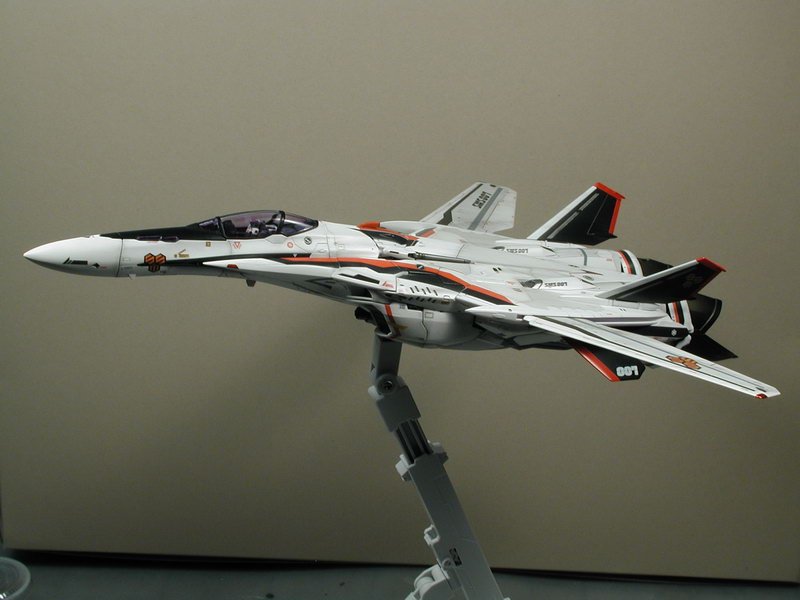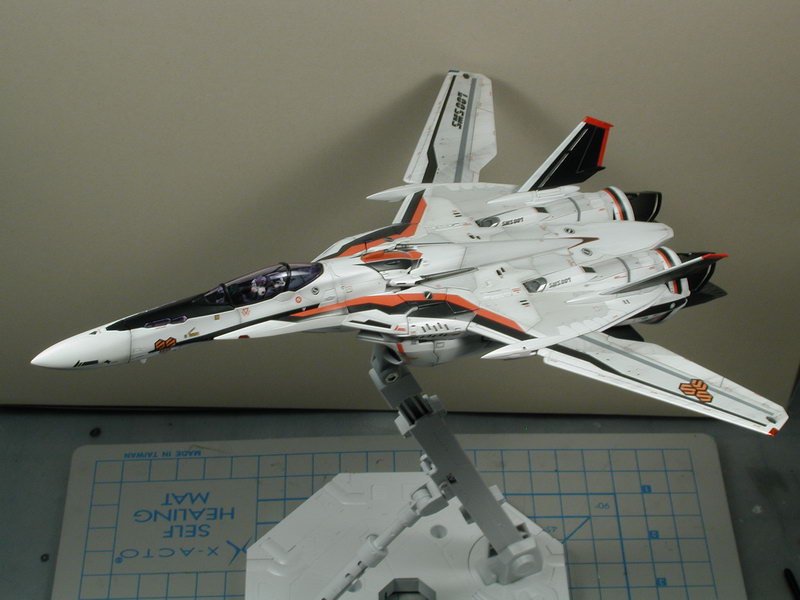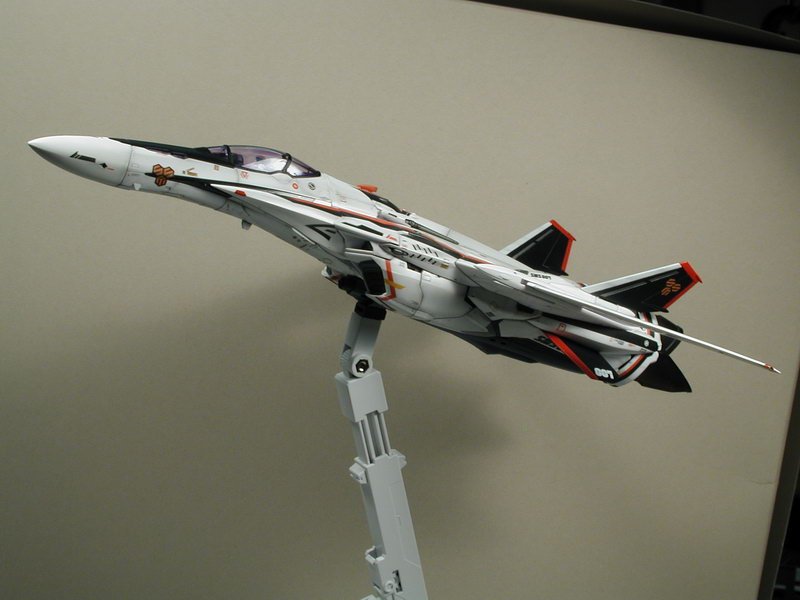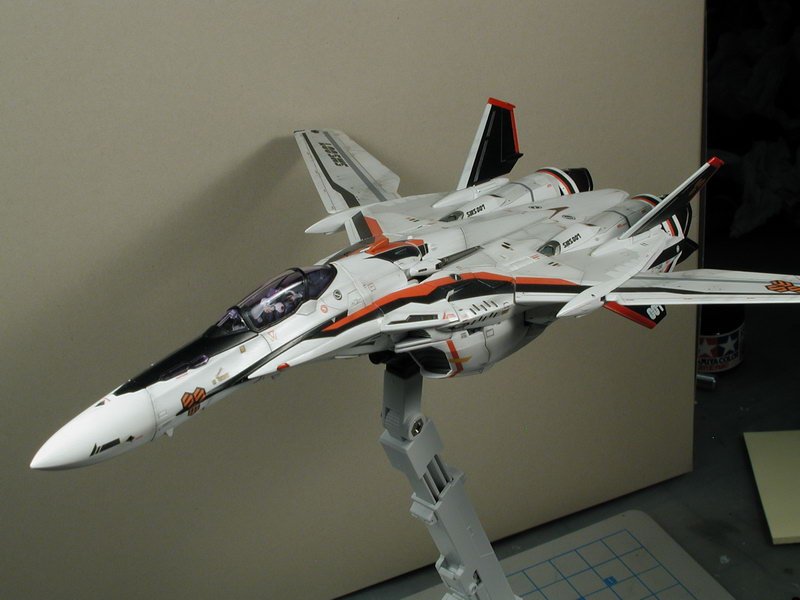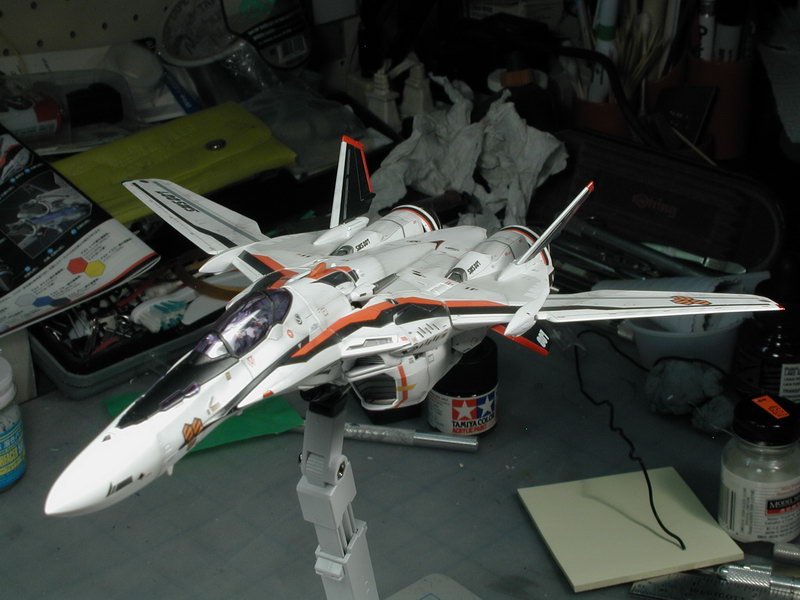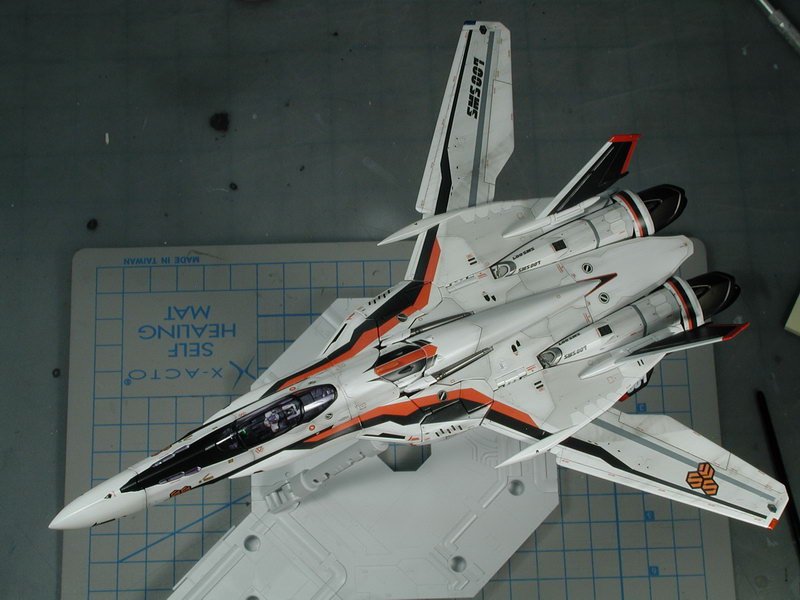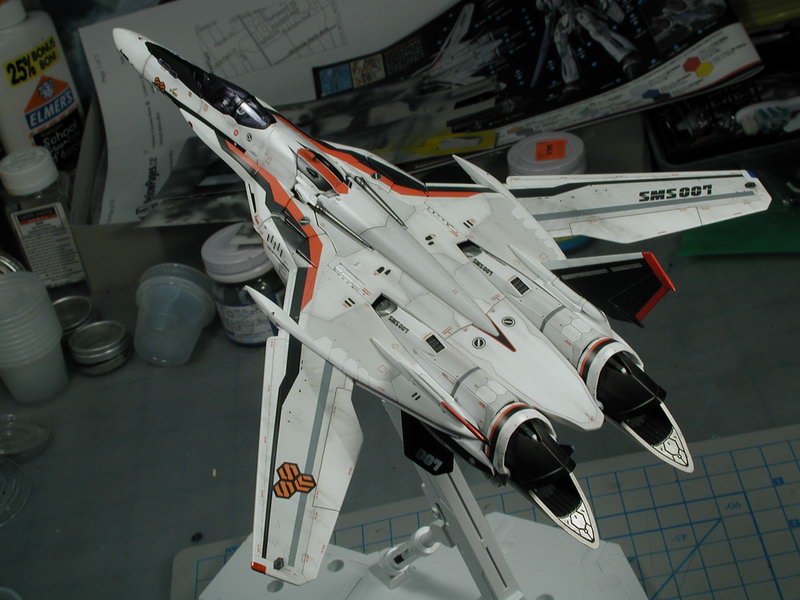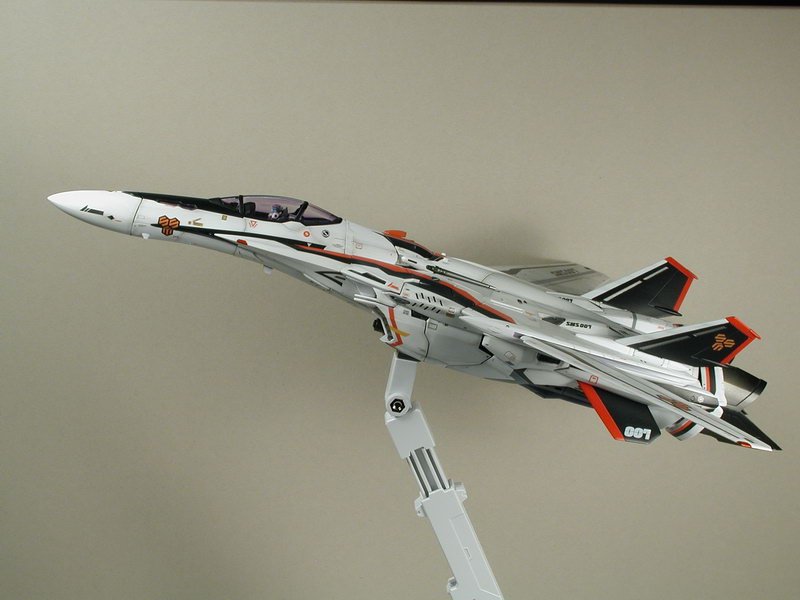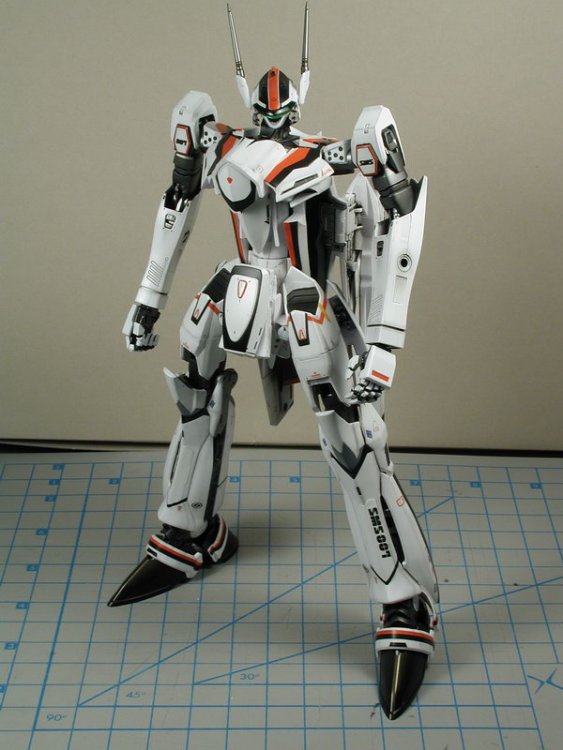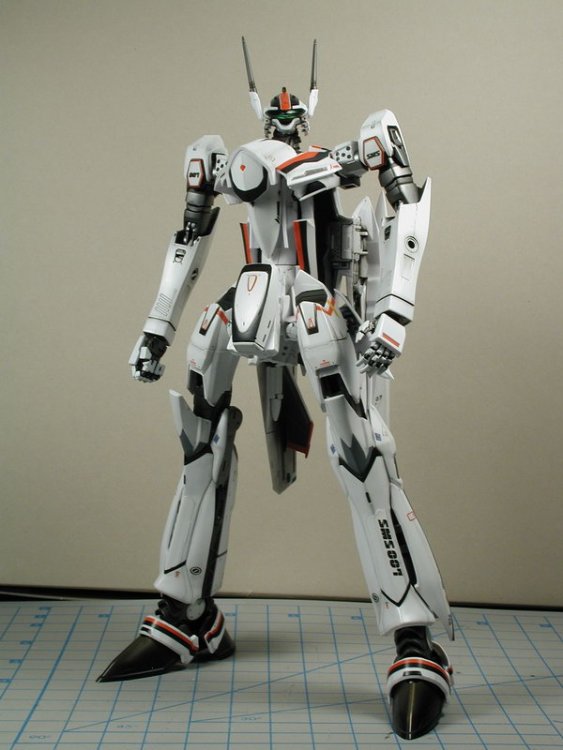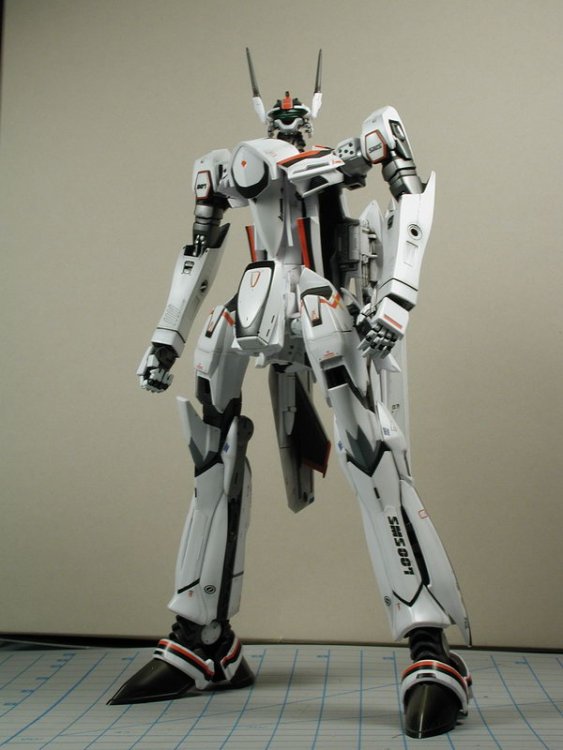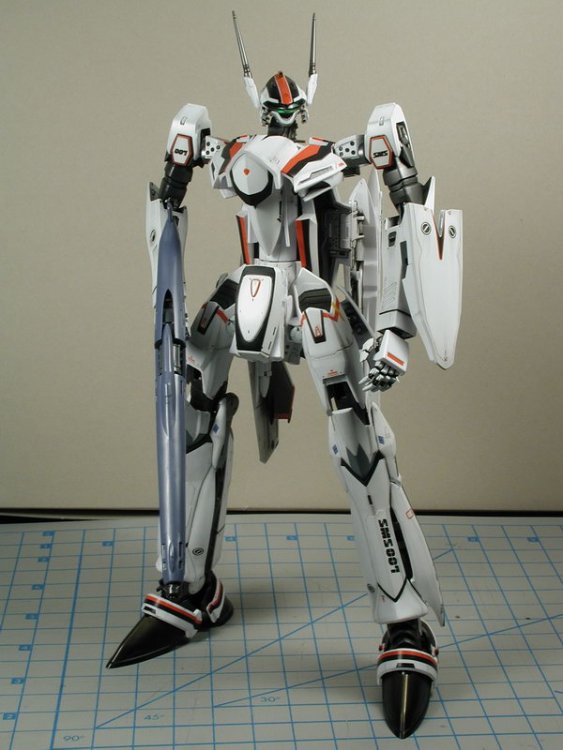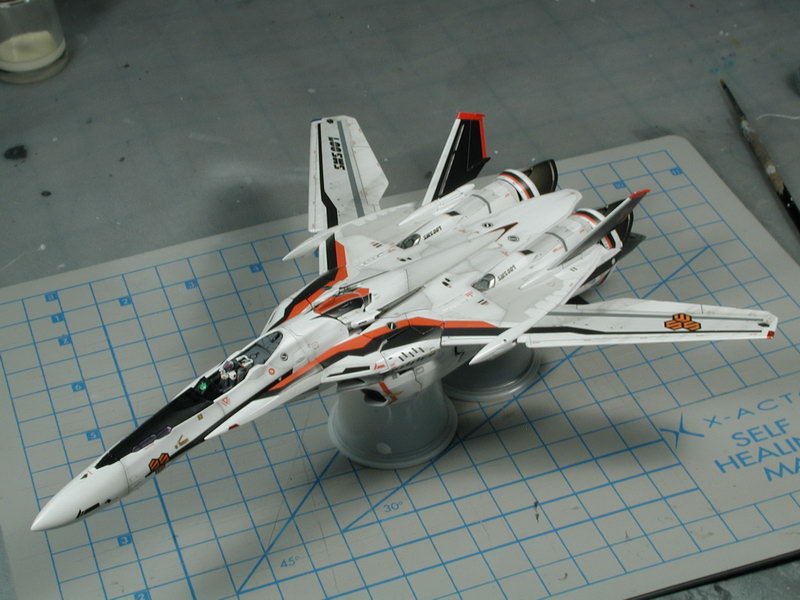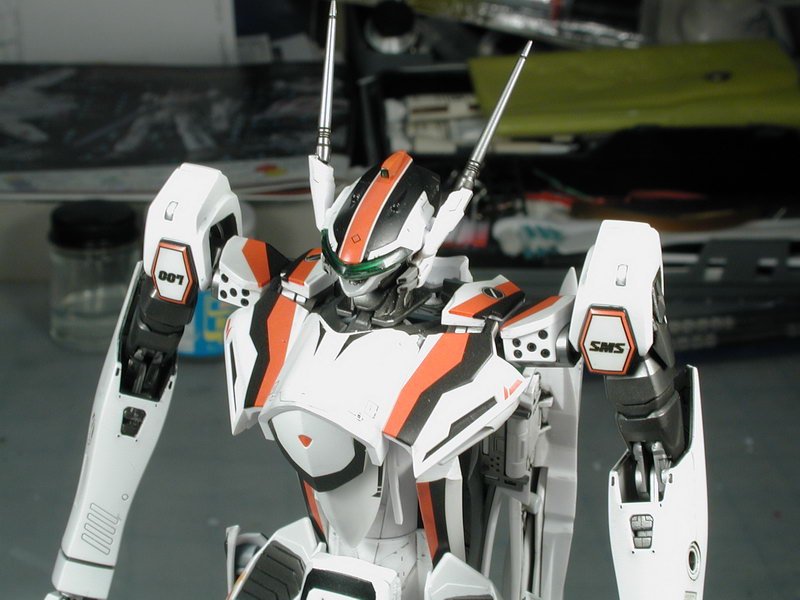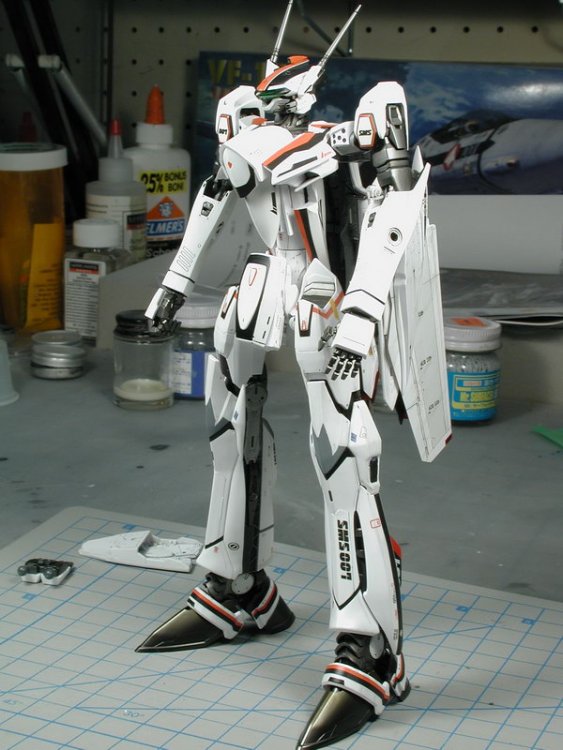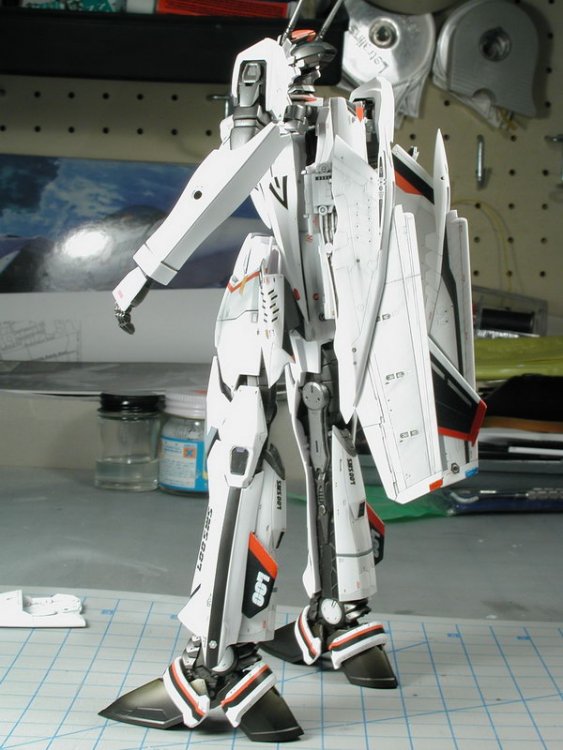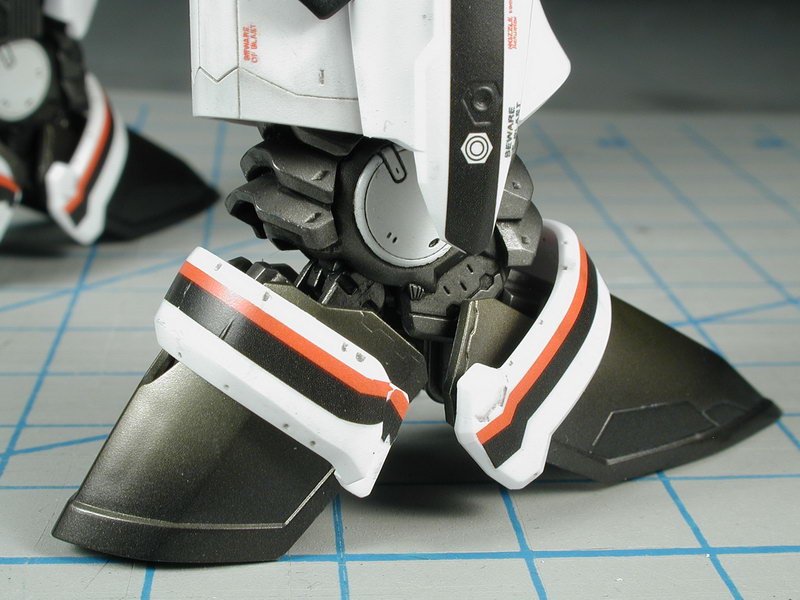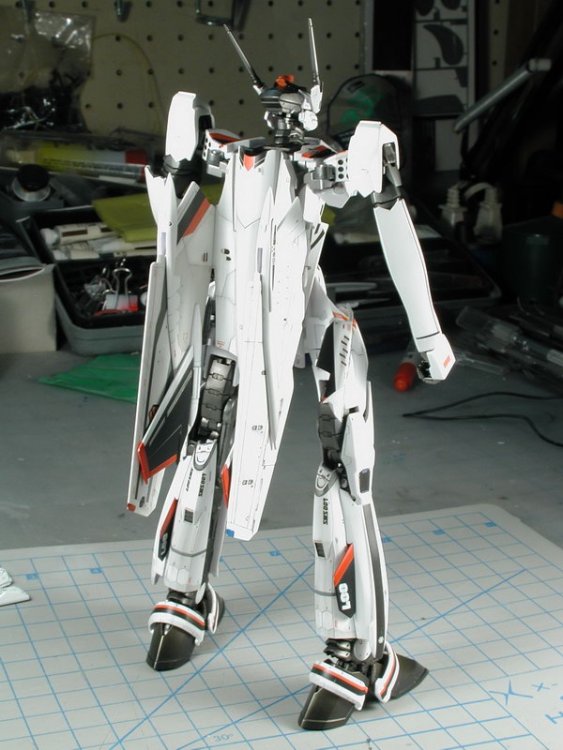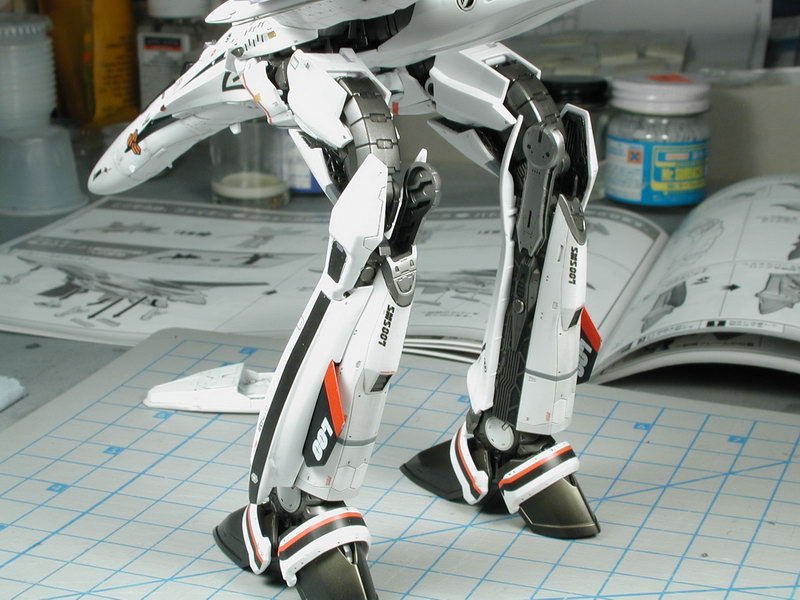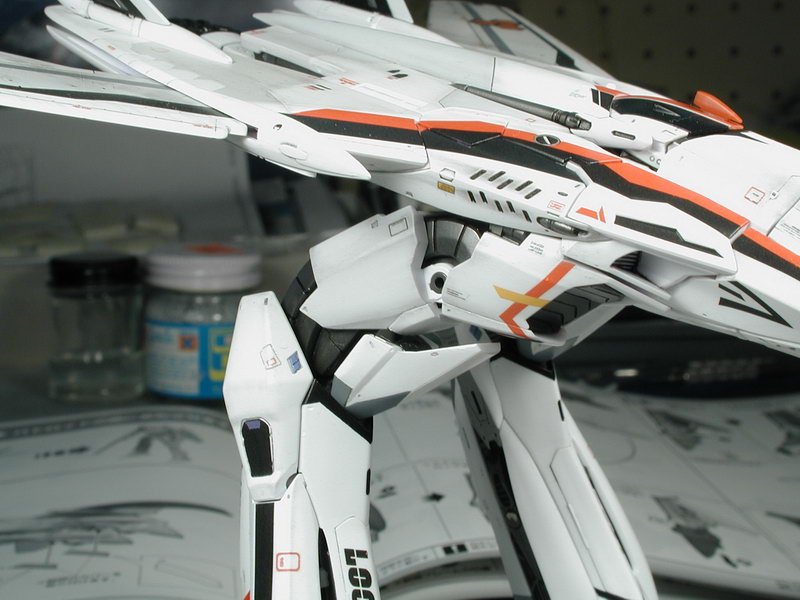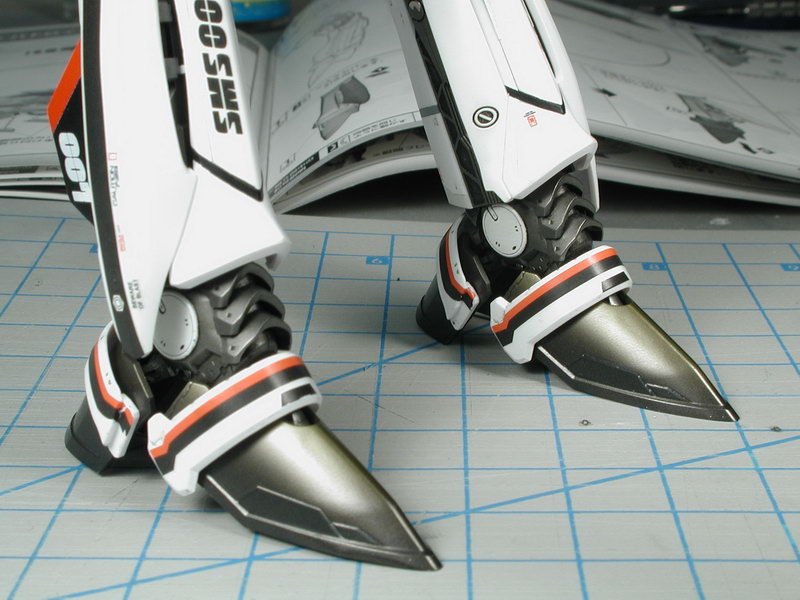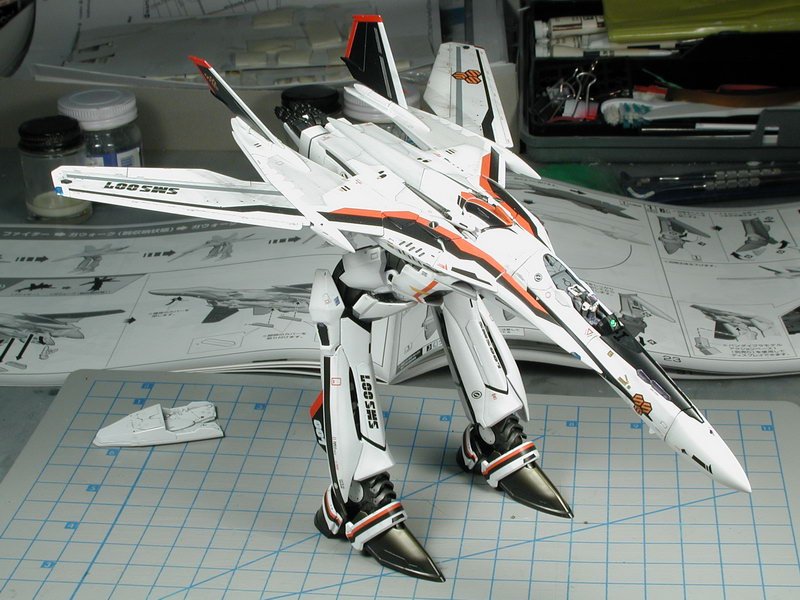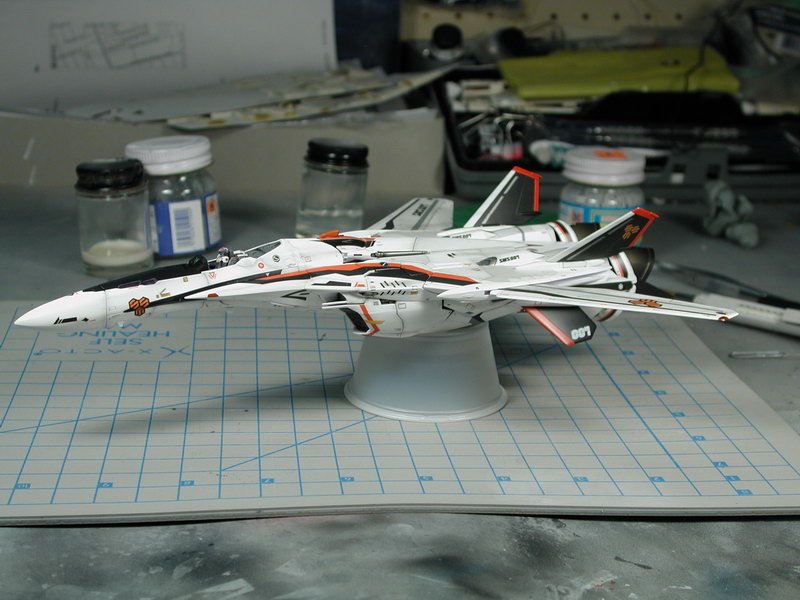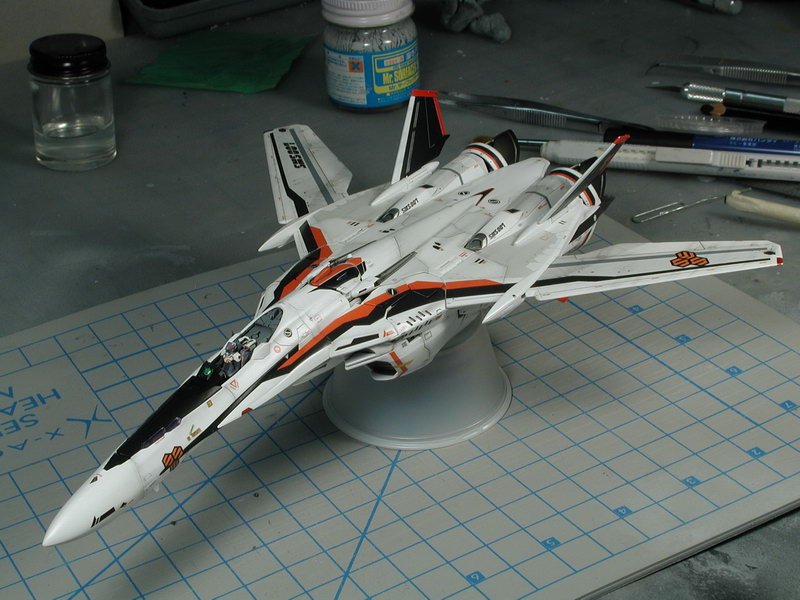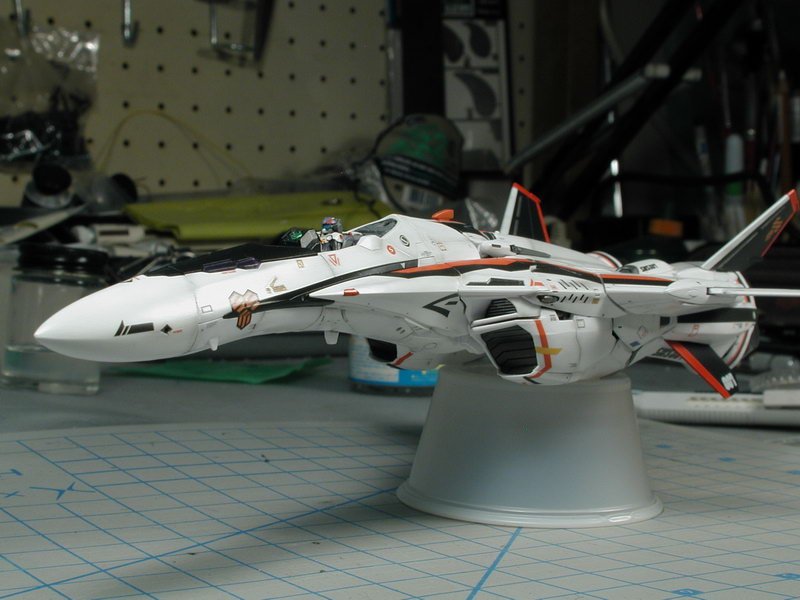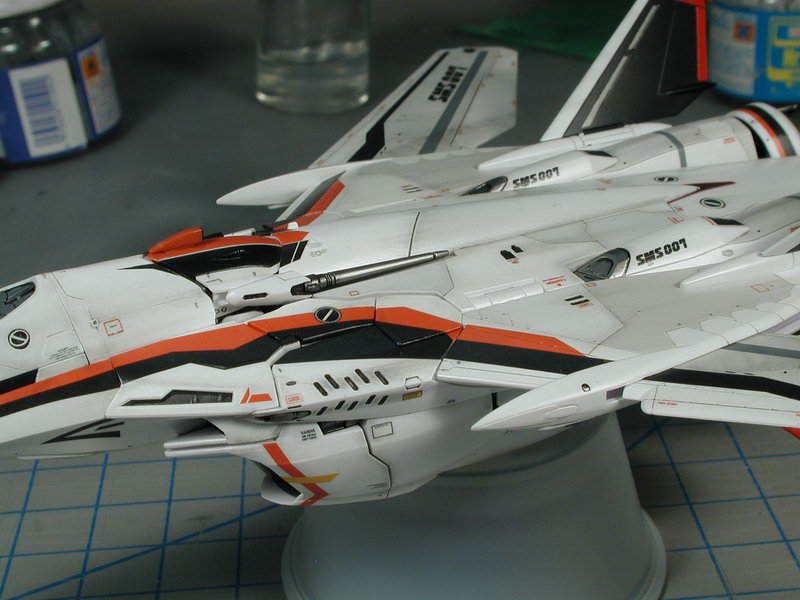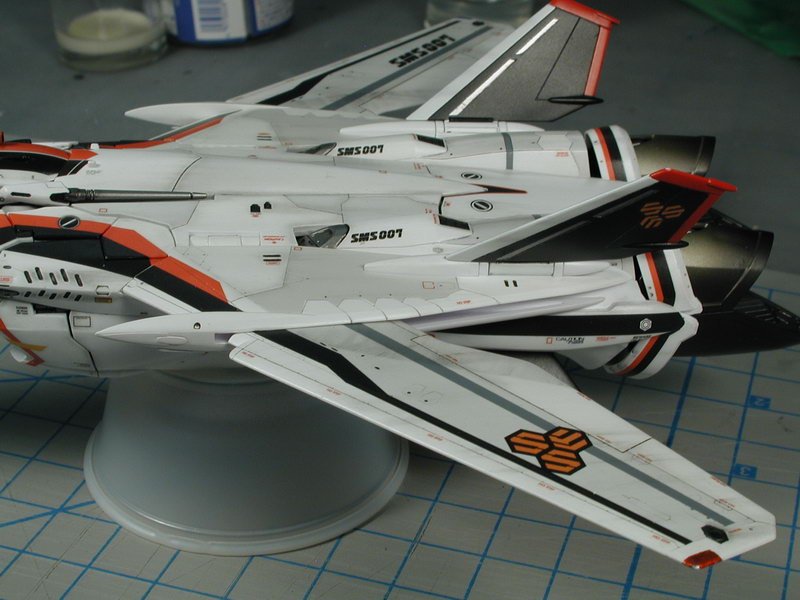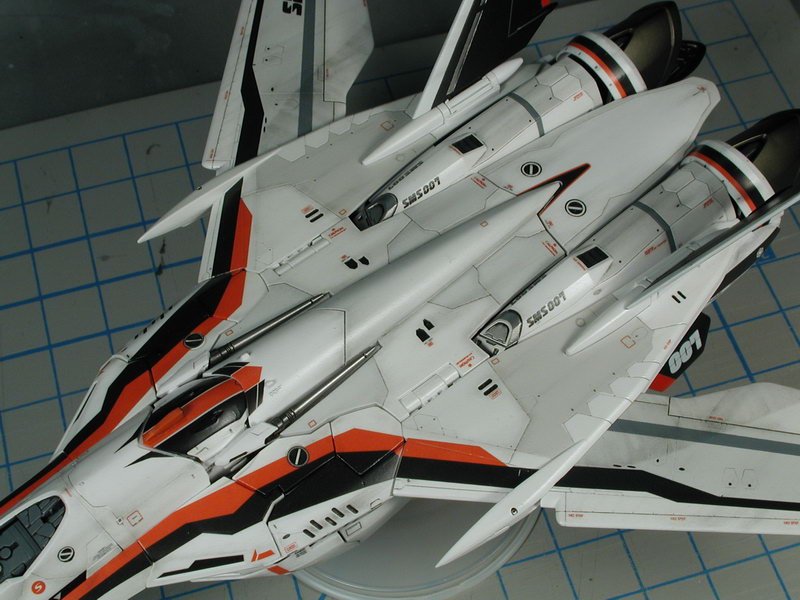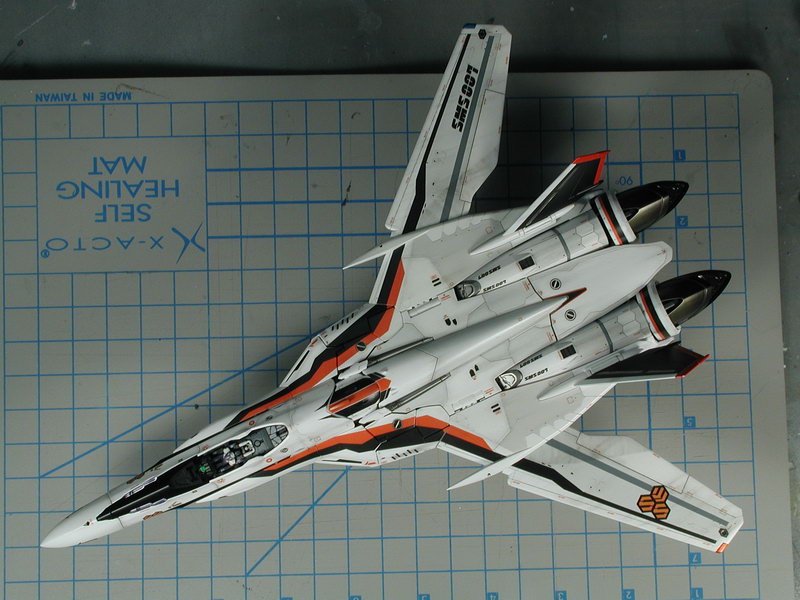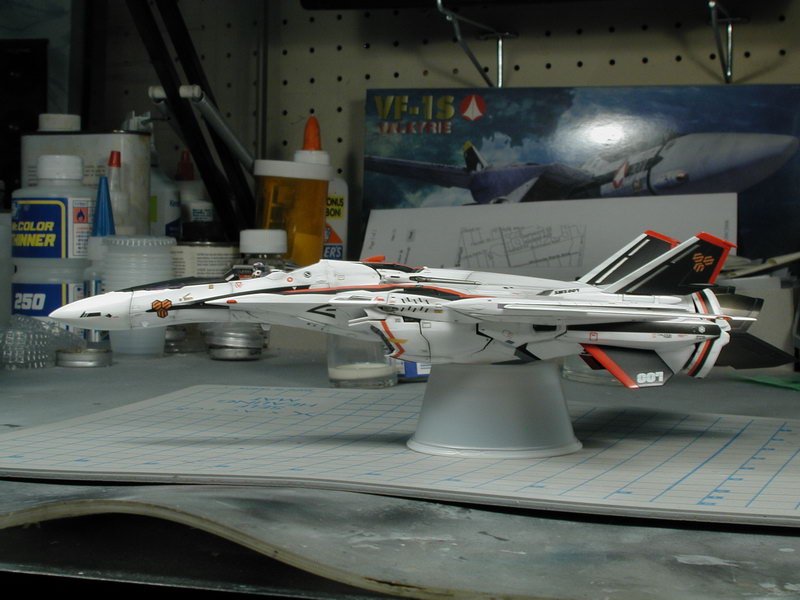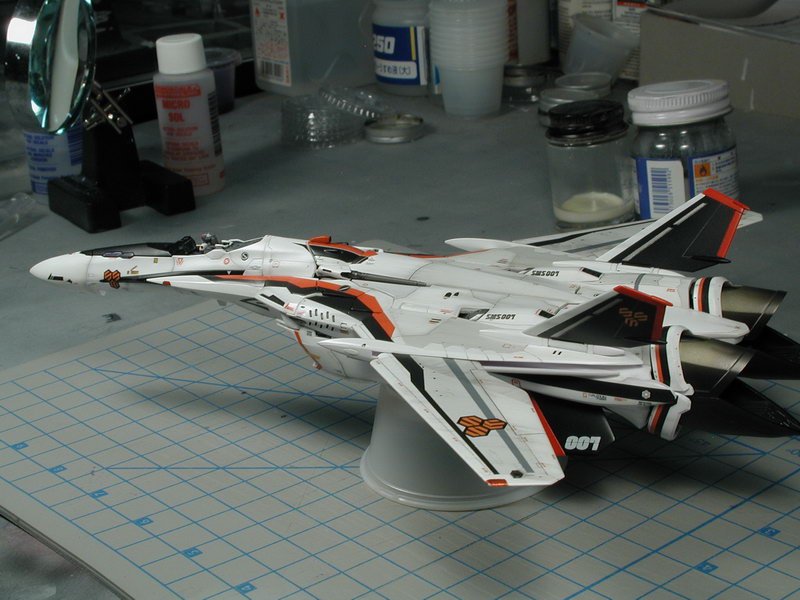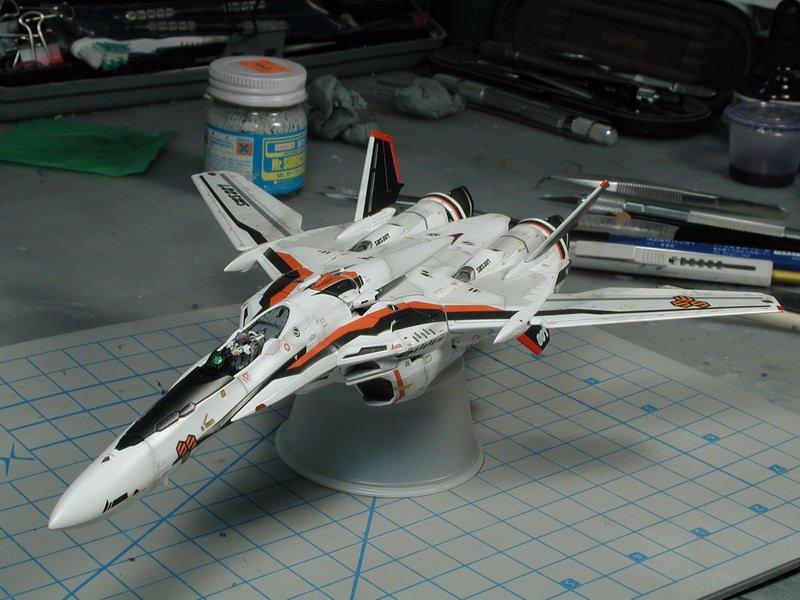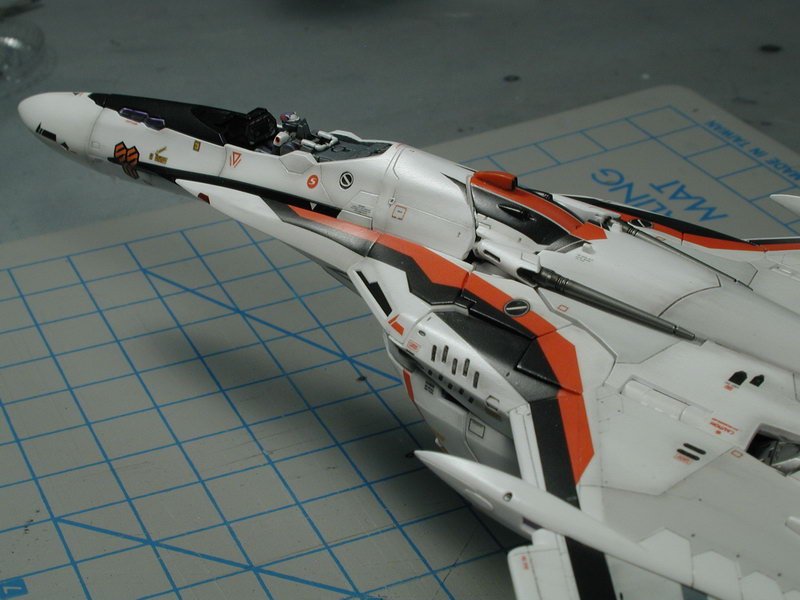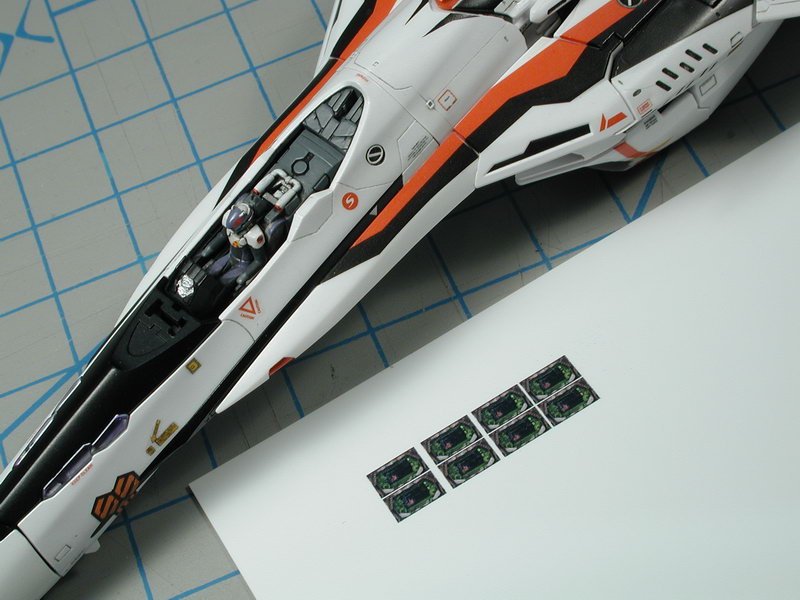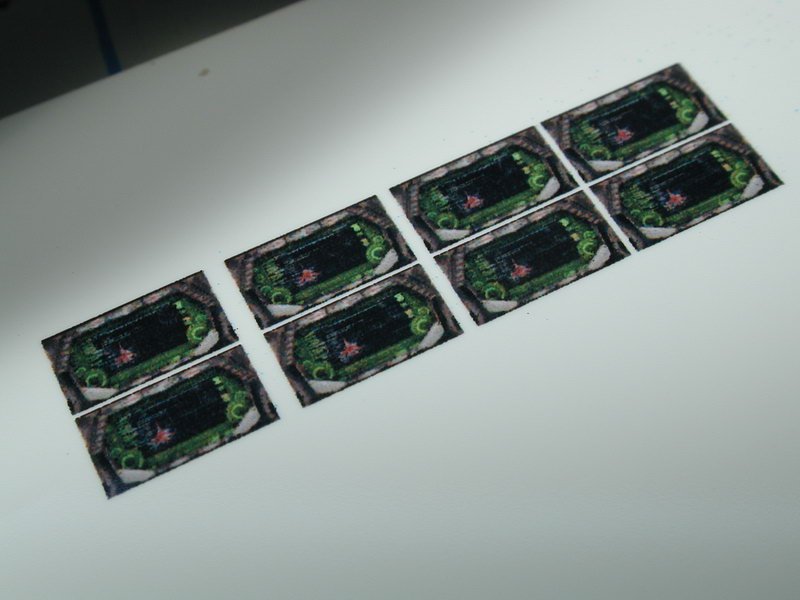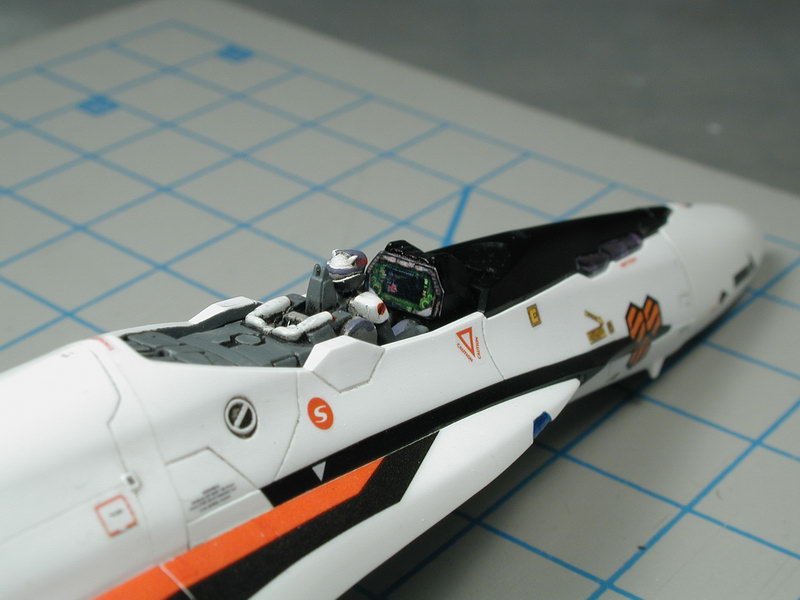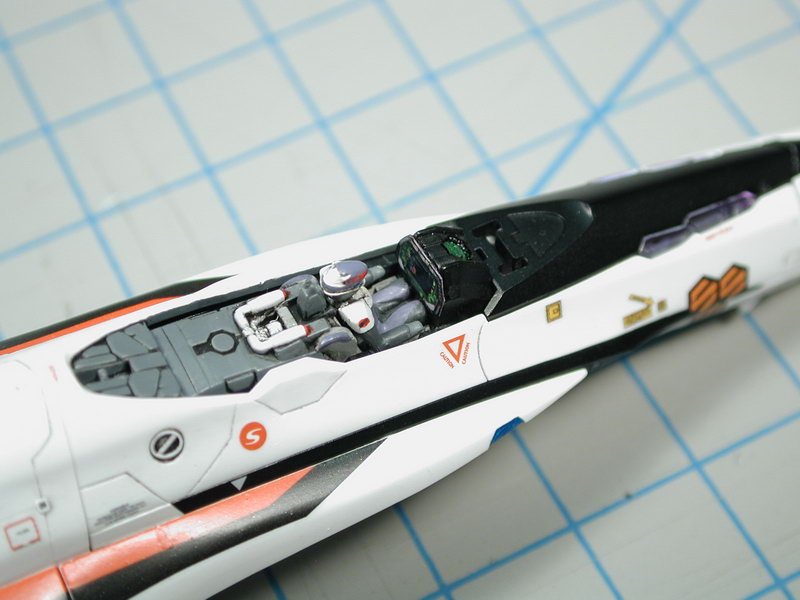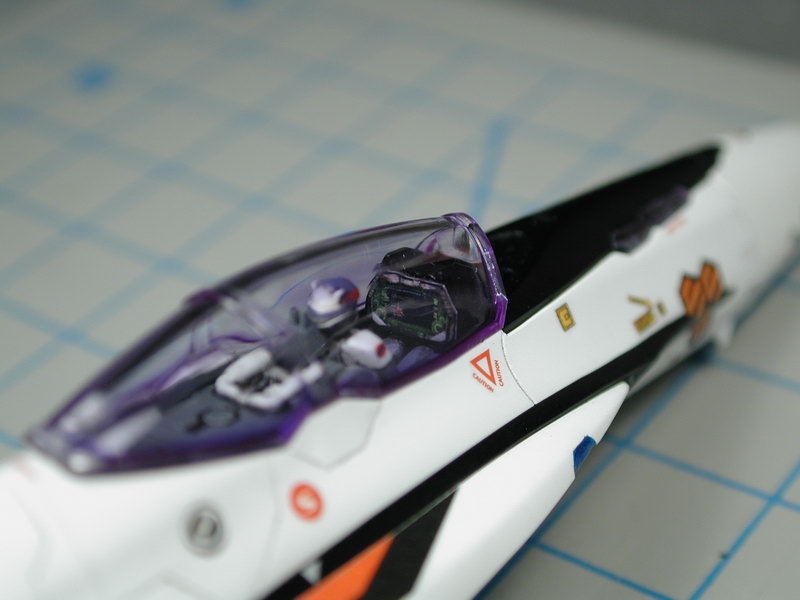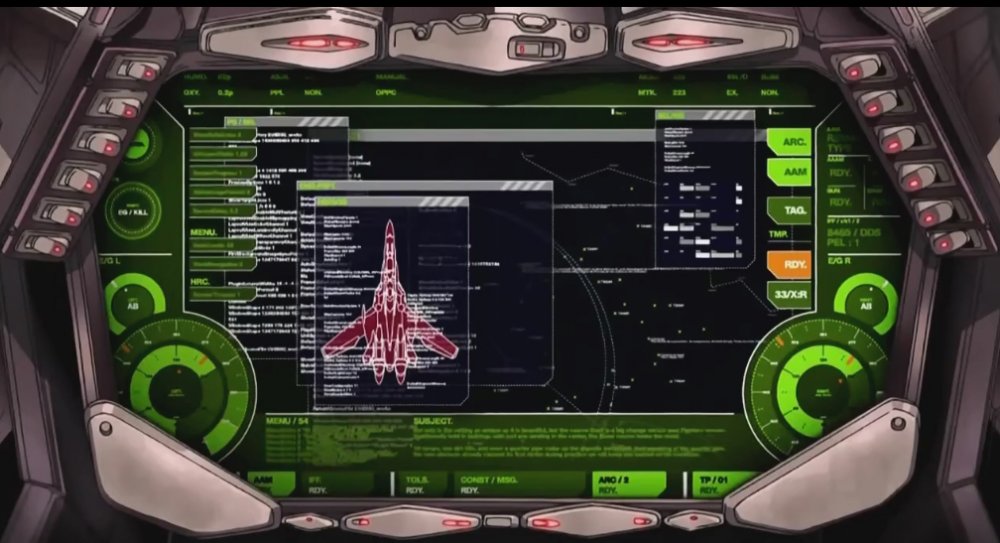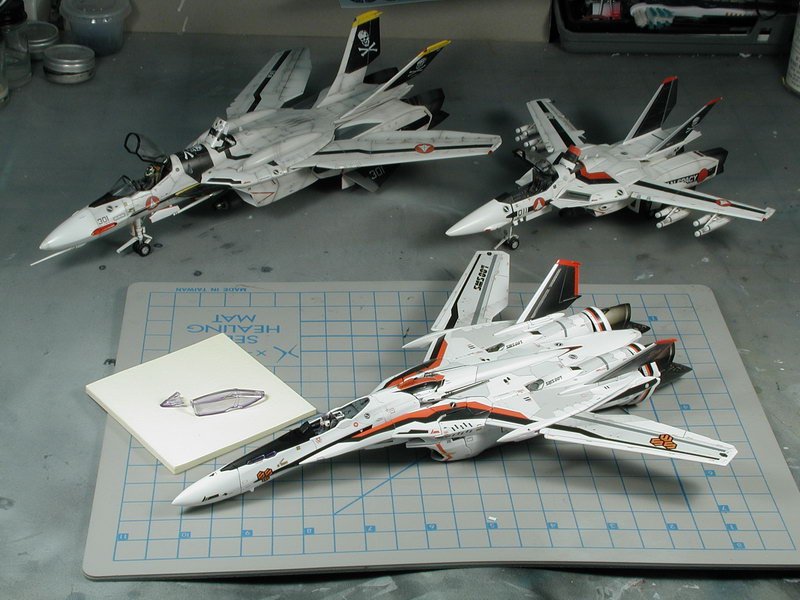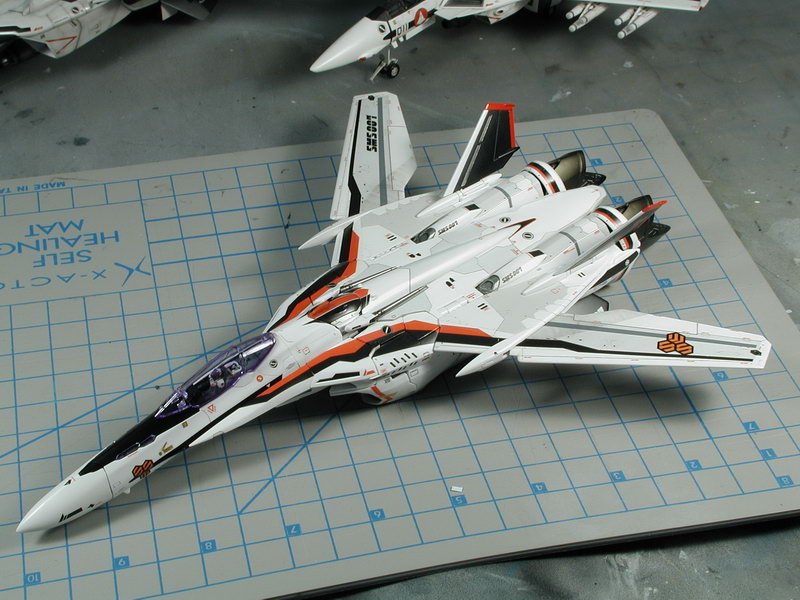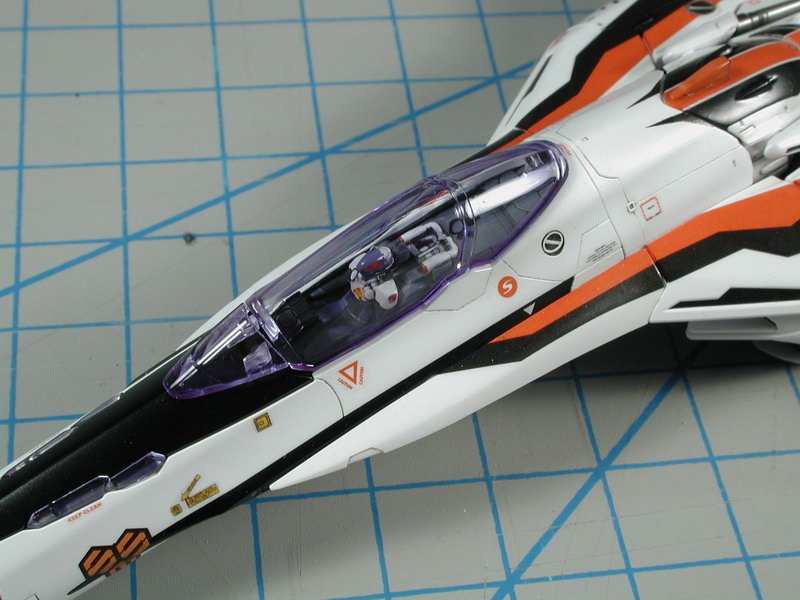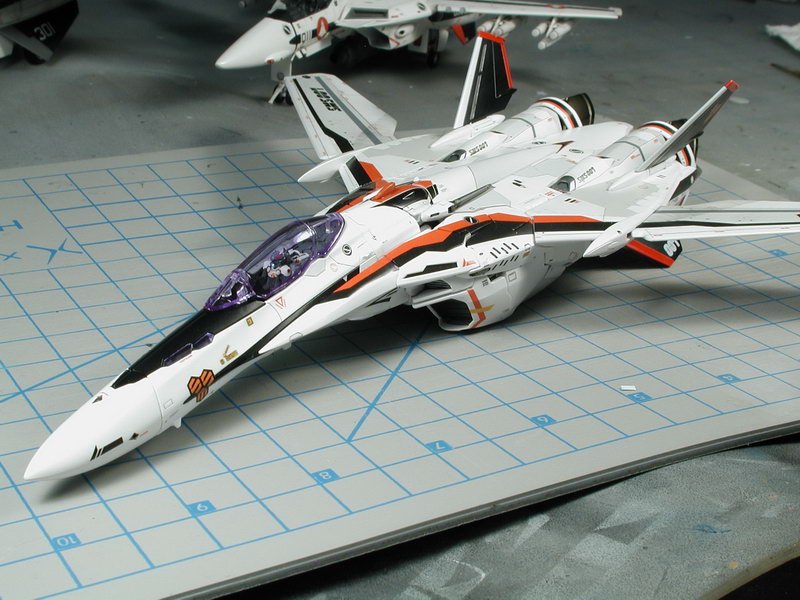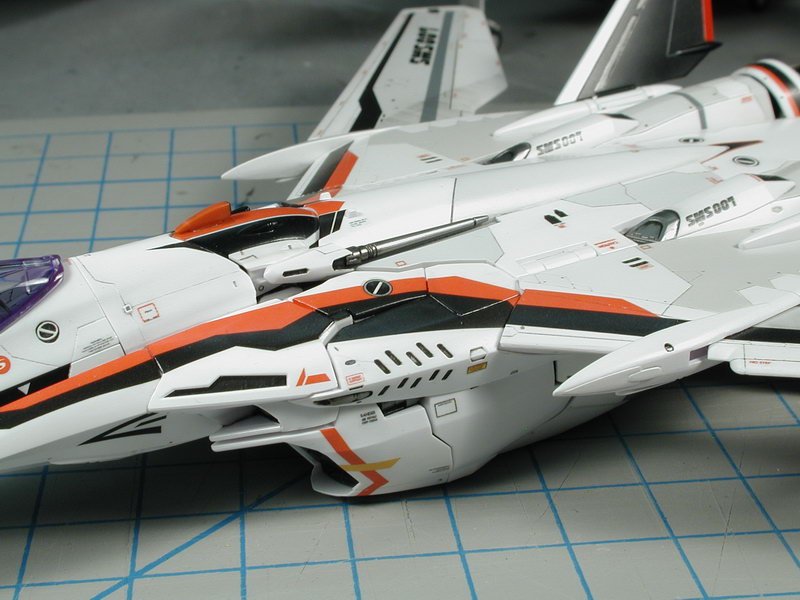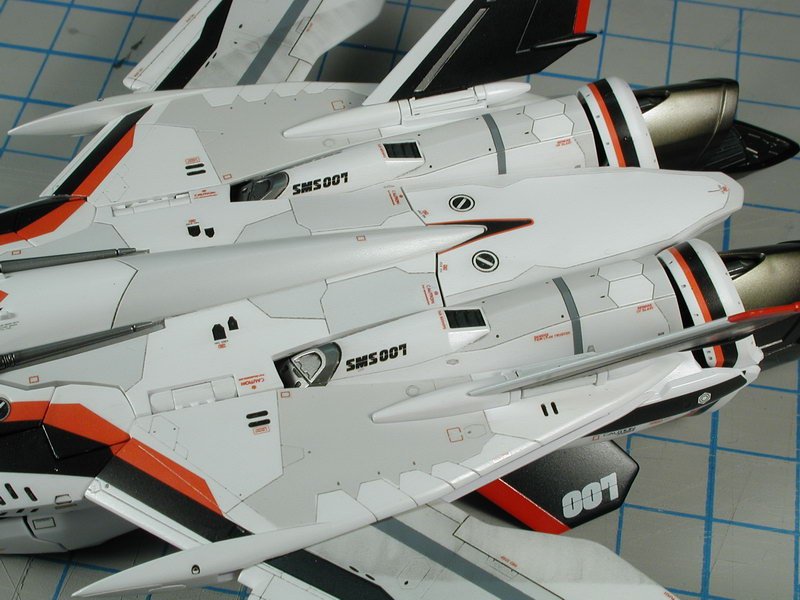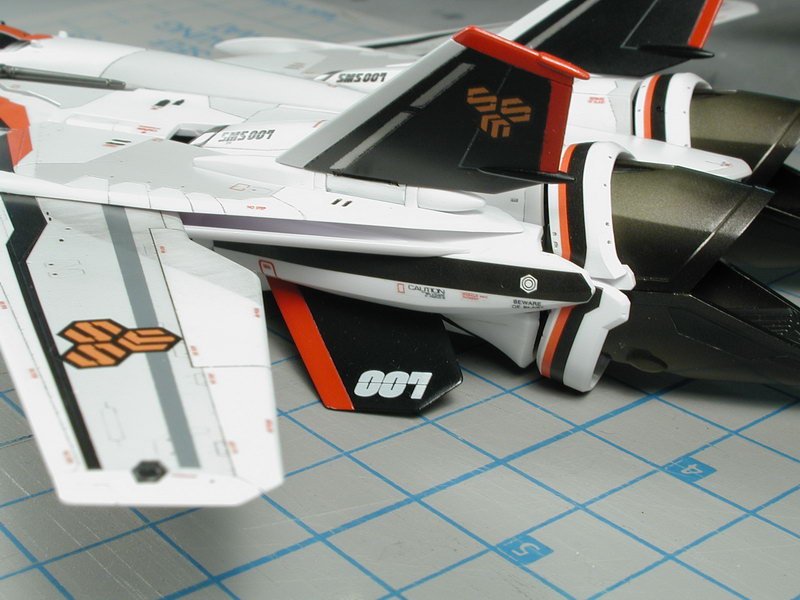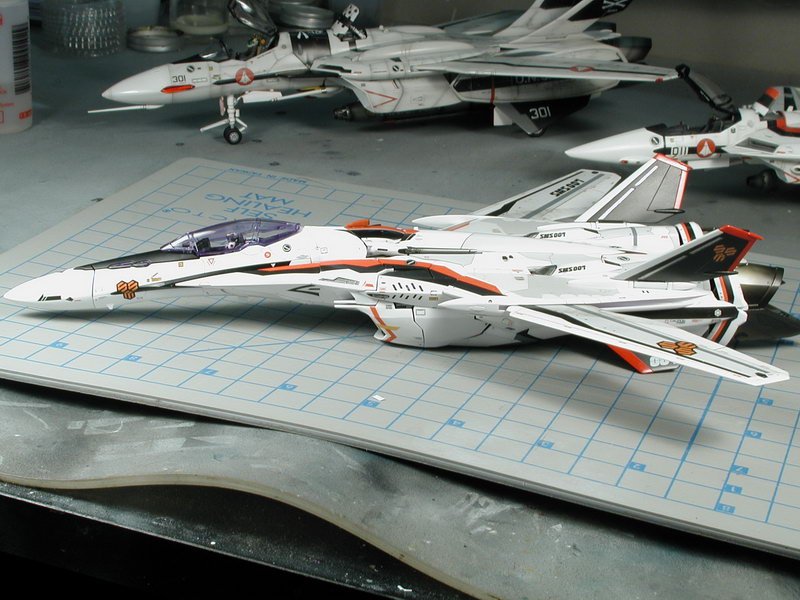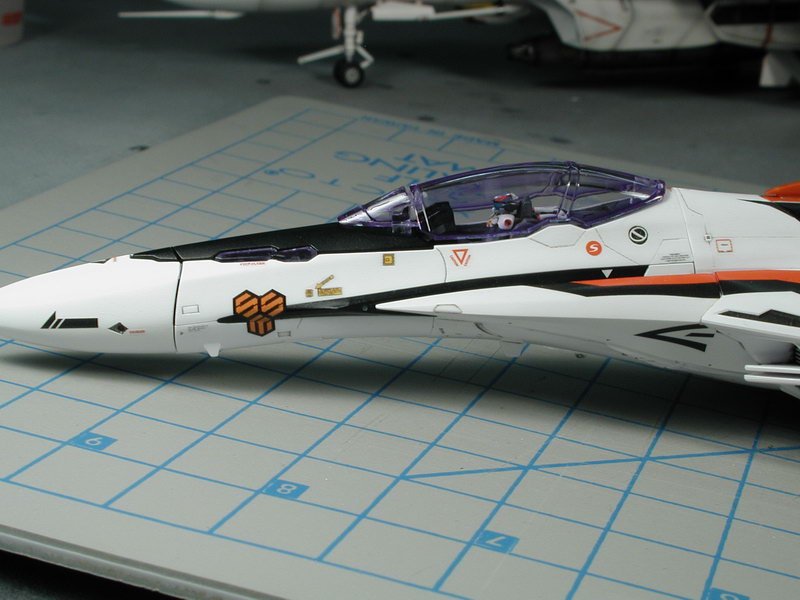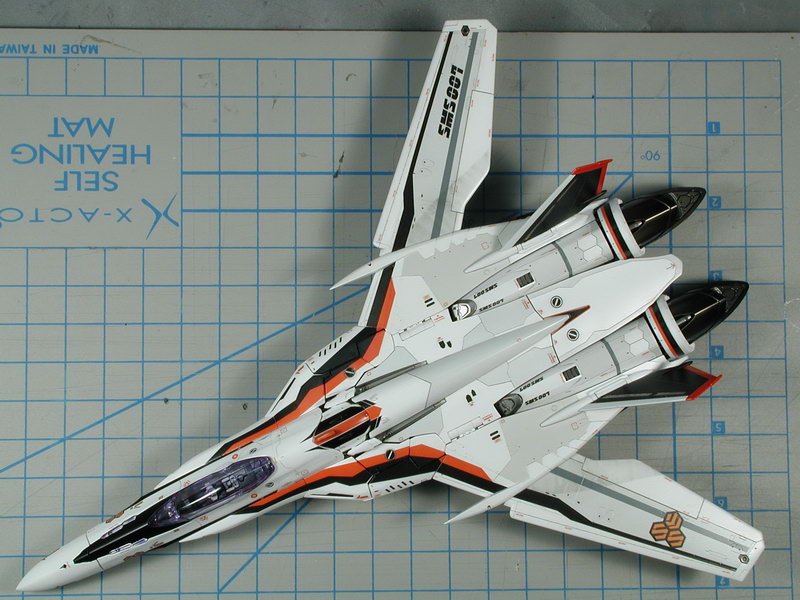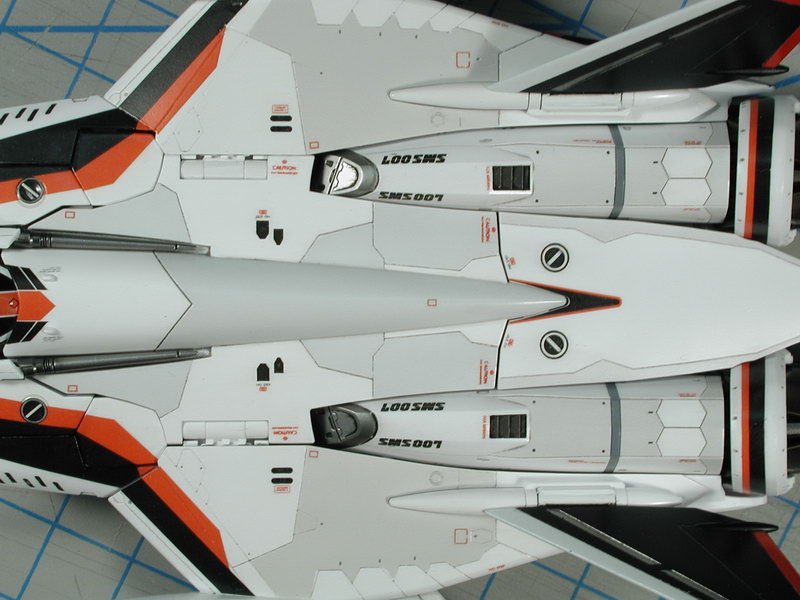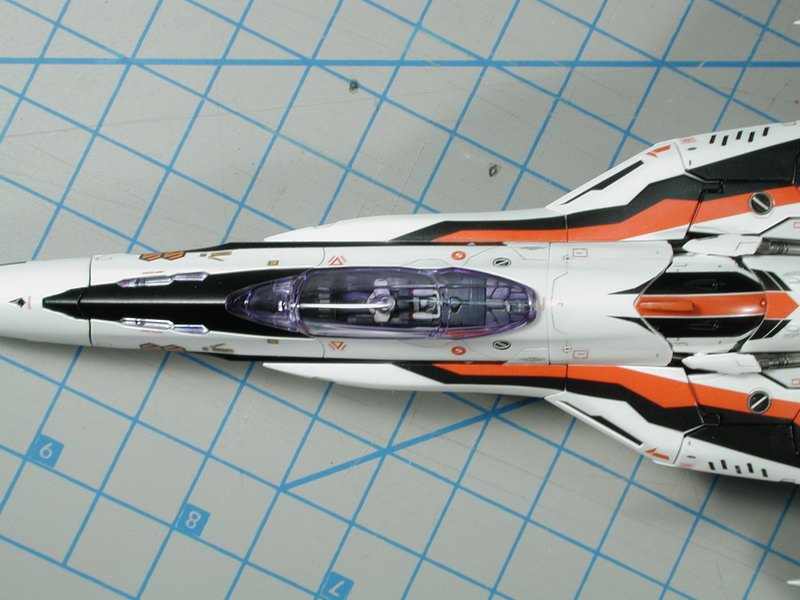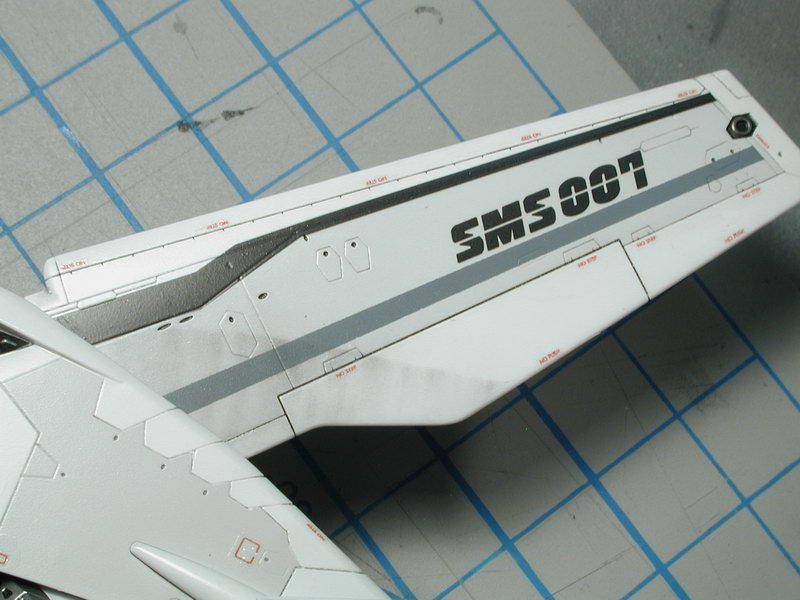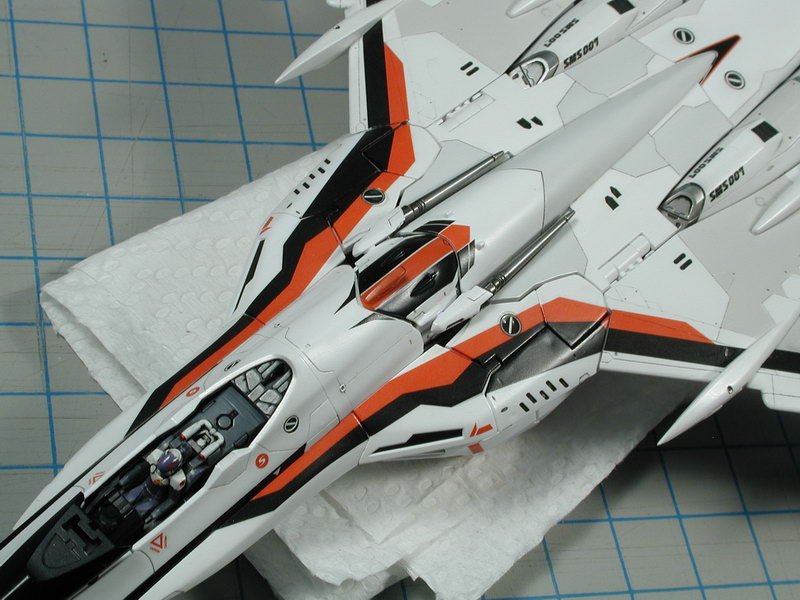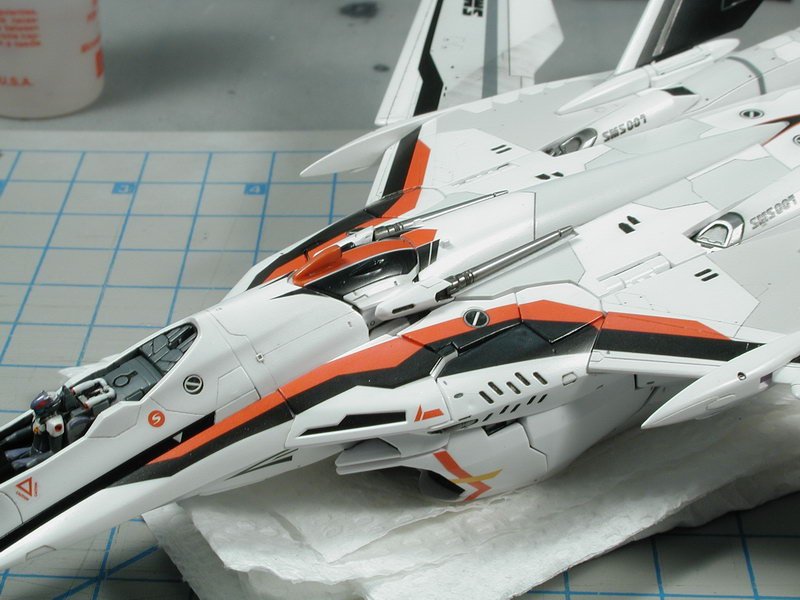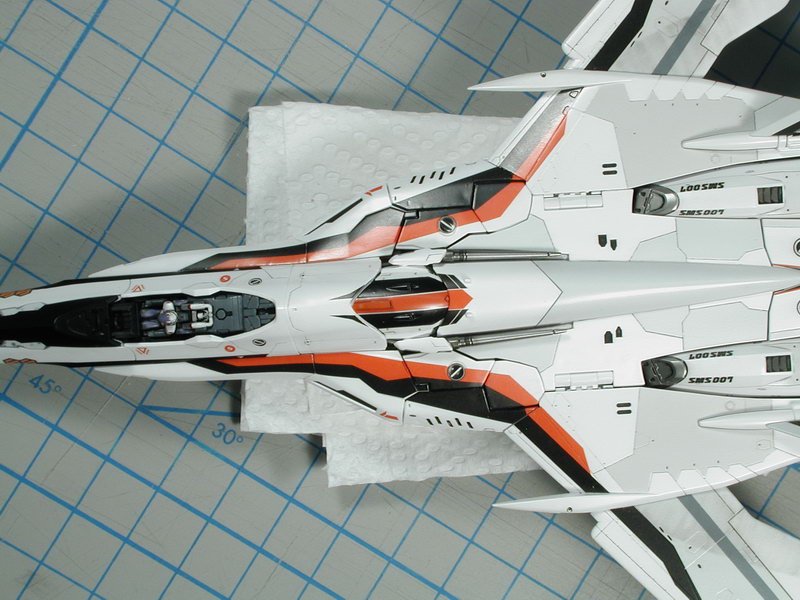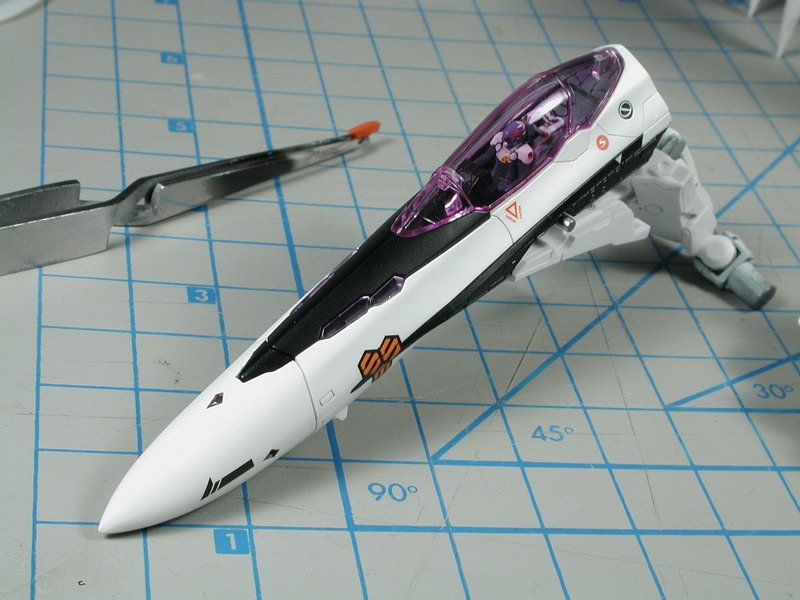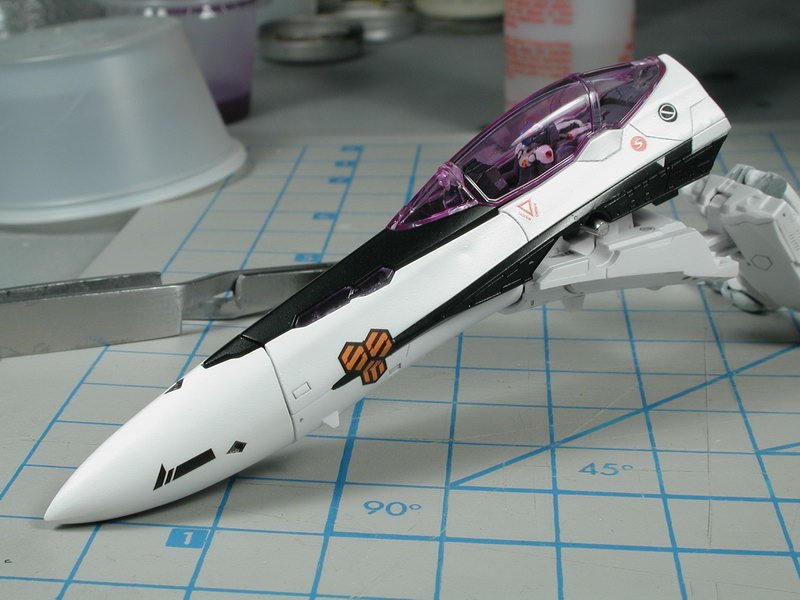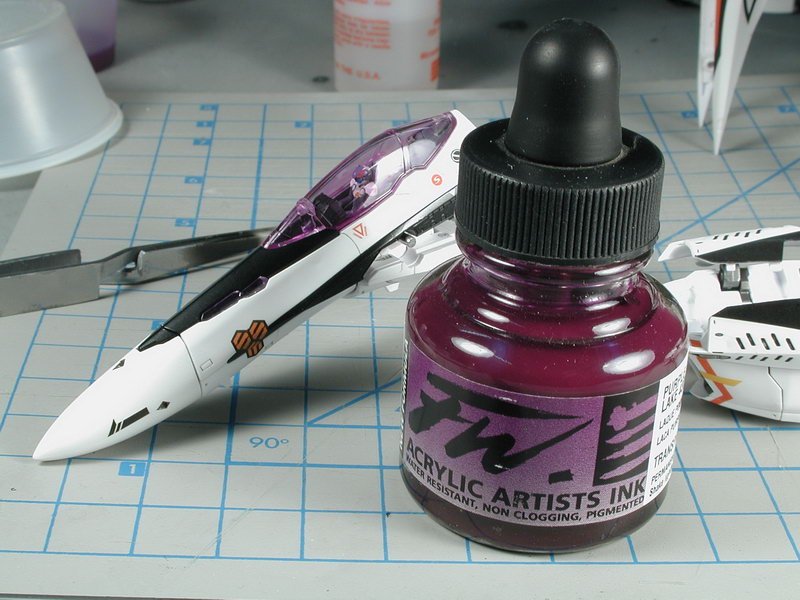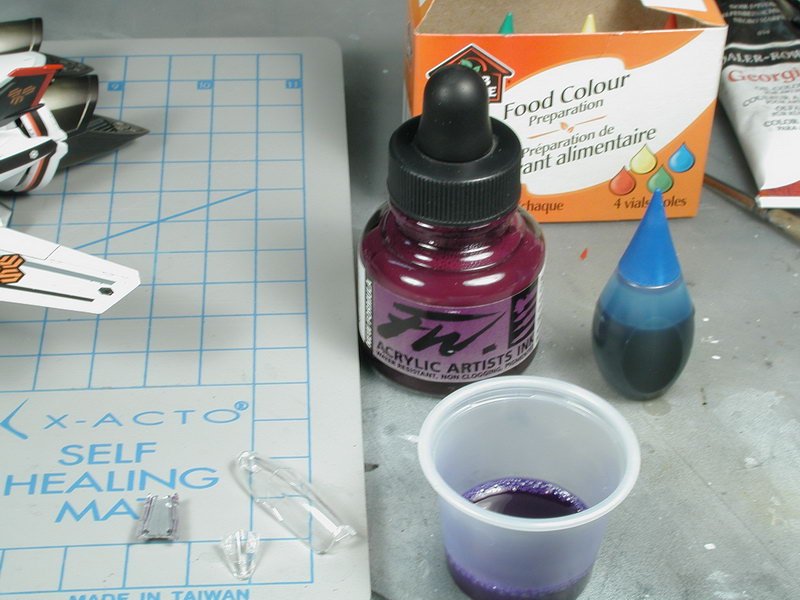-
Posts
4319 -
Joined
-
Last visited
Content Type
Profiles
Forums
Events
Gallery
Everything posted by wm cheng
-

1/72 Bandai VF-25F Messiah build-up step-by-step (sort of)
wm cheng replied to wm cheng's topic in The Workshop!
I was just going to call the plane finished when I realized that I forgot those yellow/orange sensor thingys on the wing roots (again!) - oh well, I see if I can try to hand paint those later when I work on the gunpod. Ok, so the canopy is finally on!! YAY! Here's some shots after the white shading and subsequent clear coats. Its 90% there! Argh, this has been a long haul. -

Whats Lying on your Workbench MKIII
wm cheng replied to HWR MKII's topic in Hall Of The Super Topics
WoW! That looks amazing!! King of the Micron machines... -

Bandai 1/72 Scale Macross Frontier Model Kit Thread Ver.3
wm cheng replied to azrael's topic in Hall Of The Super Topics
WoW! your workbench is neat!! I wished I didn't work in such a pig pen... Congrats on your new arrival, can't wait to see a build up thread... -

1/72 Bandai VF-25F Messiah build-up step-by-step (sort of)
wm cheng replied to wm cheng's topic in The Workshop!
I've lost count! AND it still scratches too, I guess the airbrush coats are too thin, but nothing can really withstand the scraping abuse. I've hand brushed the clear coat (much thicker application) where I think are the most problematic areas. I've learnt a lot from this build though and I would try to streamline my other builds (for one thing, I'd paint more parts before assembly and I would only do a final assembly instead of constantly assembling and disassembling all the time to see where the parts go and where they rub!). Finally finished the light weathering, I weathered it very lightly since it mostly looks new in the anime. I mostly did the weathering on the legs and forearms (to cover up parts where there was tiny damage from the rubbing of the arms folded together, but after the weathering, it just kind of blends in together. I think I'll leave this in the aircraft mode for the majority of the time, it looks too skinny without the fast packs. Hand painted the white covers to the fingers in the hands - I think it makes a huge difference to the hands. I wished continued the black stripe on the underside of the lerx (?) forward wing roots. I missed it before and now its too much disassembling and masking to do it. Unfortunately the forearm pieces started to crack along the seam after all this handling. The parts were too thin and didn't have enough surface area for the glue to hold, plus the parts flex a lot during tweaking to get the aircraft mode all fitted together properly. I'm not sure what to do differently next time, but I am not going to repair it now since it would mean completely stripping the arm down and re-gluing, puttying and re-sanding and then all the subsequent coats of paint and weathering. Yes, I'd love to do the Ozma Armoured one next! that deserves to be in the Battroid mode most of the time. I'm thinking it shoud be easier without all the subtle panel shading since its almost all hidden under the armour! I love the designs and the look of the finished models, but building is pretty laborious. I can't say that I "enjoy" these Bandai kits. The plan is to have the Michael's with the super pack in Battroid, Ozma with the Armour in Battroid, Luca naked in aircraft mode and Alto naked in aircraft mode. I still have the shoulder lights (which I save till the end, a dab of Tamiya silver marker, then Tamiya clear red over top, it gives more depth and reflection than the decals). I have the gunpod, which I will spray with Alclad metalizers first, then clear-coat with purple future to get the outer casing a metallic purple sheen. I am not even going to attempt the landing gears (this is what happens when a fantasy robot company tries to interpret wheels! ) - they are a lost cause! If I was going to do one of these VFs with the landing gears down, I'd have to deepen all the gear wells (they are a shallow joke at the moment) and completely scratch build the gears probably from the Hasegawa VF-0s as a base, but they would not be removeable and it would be a huge undertaking in itself. I still need to mask and spray those yellow/orangy thingys on the side of the wingroots - now that really should of been a decal! I don't know if I might try to hand-paint them. Lastly its back in the plane mode again awaiting final light shading/wash spray of thinned white to tone down the panel shadings, off-grey panels and tie in the contrasty black and red markings to generally tone down the markings to look more "painted" on. It survived the transformation rather well with only 2 or 3 chips or scrapes (even with the clear coating). Warning, the black top area to the forward nose cone seemed to be rubbed the most in the Battroid mode - unfortunately its a prominent part when in the aircraft mode - I handbrushed more clear coat, but you should all watch out for this area. -

1/72 Bandai VF-25F Messiah build-up step-by-step (sort of)
wm cheng replied to wm cheng's topic in The Workshop!
So far so good... I can see areas that were in pressure while in the aircraft mode now. Mostly the top of the shoulders, inside of the arms (forearms) as slight rubbing on the clear coat. There's nothing that can be done, I just hand-brushed another coat (much thicker than airbrush) over these problematic areas. That too will eventually damage, but the idea is to not transform it that often. Now I'll selectively add a few more data/stencil decals that are exposed while in the Battroid mode so that it doesn't look too bare. The main purpose is to weather it to look in place with the top of the aircraft weathering job done previously. -

1/72 Bandai VF-25F Messiah build-up step-by-step (sort of)
wm cheng replied to wm cheng's topic in The Workshop!
Ok, another few hours and several clear coats later... I've lost count of the number of coats now. My first time to transform this puppy, I need to get it into the Battroid mode to see if there are any unpainted or un-clear coated gaps and weather all the bits that I couldn't access while in fighter mode. Believe me, I don't want to do it more often than I need too! The initial transformation seemed to have gone well. I love seeing the metal bits poke out through the skin like a motorcycle. -

Bandai 1/72 Scale Macross Frontier Model Kit Thread Ver.3
wm cheng replied to azrael's topic in Hall Of The Super Topics
WoW! Congrats Jarrod... it looks great and with such speed you got it together... Thanks for putting up the pictures so quickly. Now I want one too! The regular Battroid mode just looks anorexic - this is so much more fun! (and probably a pain in the ass to build and paint properly!) some day... -
Good discussion... I'm still of two minds on the whole issue. I would personally prefer Hasegawa's style of models myself (its just fits my "old-timers" style of building better). BUT, having said that and seeing all the real bricks and mortar hobby shops around town closing up - its clear that this is a dying hobby (wasn't there a japanese hobby (real model only) magazine that ceased print last year?). Anything that attracts new builders is a good thing for the hobby as a whole. And I've seen tons of posts about people who have never tried to put together a model before attempt to build the new Bandai VF-25 - what a great thing that is! Well, to be fair, they were driven to it due to Bandai's own poor execution of their DX toy line - but still good for the modelling hobby! So I must commend Bandai for that! Me personally, I'm having a really hard time building up the VF-25 from Bandai properly, and its all these "easy" features that they attempt to engineer into it that screws up the traditional modelling build. You can hear me whine about it on my build up thread, I won't bore you with the details. Let just say Bandai kits have their own audience and they cater to that extremely well, but that is not to be confused with the traditional modellers out there. Also lets keep in mind about the panel lines issue... Gundam designed universe uses extremely large panels and assemblies, if you look at some of the chest pieces and where they chose to break up the sections into panel lines, they work out to be huge (easily 10-14ft sections!) pieces - fine for anime, but pretty impractical for real-world construction. I understand that the anime art doesn't want the sweat shops to have to draw in all the necessary panel line lines for every frame of the animation. But if we are to linger on a model for more than 1/24 of a second, there needs to be a bit more interest in the model to captivate our gaze. This is where Hasegawa shines! It makes up additional detail that is realistic and convincing drawn upon their years of making real-world aircraft (maybe their YF-19 & 22 should be excluded from this statement, I was a bit dissapointed with their lack of additional details for these entries). Bandai never has put anything more into their models than what was originally drawn - as a result, the models still look like anime, it never transcends that cartoony look to become something that may have been real (which is generally the goal of most traditional modellers). Also with such large pieces, its easy to break down the plastic parts into these components for building along existing lineart panels and creases, because the Gundam design permits such crude parts breakdown (also I'm sure the anime design is always designed with merchandising in mind right from the beginning). Real aircraft is usually more complex... too complex for such simple breakdowns. An example is their Yukikaze EX line of static models, aside from the fact that Bandai has never gotten their landing gears right or really knows how to scale properly, they seem to always undersize their models somehow - they follow all these panel lines in the line art that start and end in the middle of a surface?!! They don't have any understanding of how real world things are built, they just slavishly follow the anime lineart without thinking. I'm sure it was a design or animation error, but its pretty wierd to have a static model with the etched panel lines end without terminating in an enclosed panel. OK, believe it or not, I would also like to add that I hate it when the pieces breakdown and assemble right on the panel lines. I find that often when you glue it (of course this is key, you snap together a Gundam kit) no matter how careful you are with the glue, it often oozes slightly out of the cracks, which in this case it means it will ooze into the panel lines. So I have to then repair the panel line and take out the ooze, which is harder to remove the ooze than from a surface since its in a recess valley (panel line). Often, I find I have to completely erase the panel line with putty, then sand smooth just to re-scribe that panel line (which no matter what you do, will be a slightly different panel line than the surrounding molded in panel lines - you have to find the closest tool you have that will re-create the trench to match the other panel lines). I would much rather they put the piece separations on some part of the assembly that is either hidden when built or some smooth piece with relatively little detail around it so that it can be sanded down without obscuring any details. Ok, thats my two cents. I am looking forward to this Hasegawa 1/48 entry, but personally at 1/48 scale, it would take too much work to properly detail this thing up as the size demands. For example, at 1/48 scale, the landing gear wells and structs really need all the hydraulic break lines, disc brakes, hydraulic fluid reservoirs and cylinders modelled, the myriad of electrical bundles in the bays added to do this scale justice. Also, out of all the Hasegawa 1/72 scale kits, I find the YF-19 to be most lacking in detail of all of them - great generall overall shape, but not a lot of additional detail (plus they got the rear gears wrong). Odd choice for a first 1/48 entry - I'd still love a VF-1 in 1/48 from them!
-

Whats Lying on your Workbench MKIII
wm cheng replied to HWR MKII's topic in Hall Of The Super Topics
OMG!! I'm speechless... that's amazing, it would be my wetdream to paint that!!! Wow, I definitely want to see it finished, how big is it? You wouldn't be making something like that of the old original big G would ya? Any resin copies coming out? ;-) -

1/72 Bandai VF-25F Messiah build-up step-by-step (sort of)
wm cheng replied to wm cheng's topic in The Workshop!
Yes, I find the decals really poor quality. They just flake off or is really brittle, even after application and it had the chance to dry. You really need the clear-coats to protect the decals just from handling, let along the scraping due to transformations. -

1/72 Bandai VF-25F Messiah build-up step-by-step (sort of)
wm cheng replied to wm cheng's topic in The Workshop!
Thanks for the kudos! I still haven't managed to get to the light white filter yet, it should tie the contrasty black and red stripes in a bit more to the white paint finish. I've got to take the who thing apart again! to weather the arms and inside legs so it doesn't look weirdly clean when its in the Battroid mode (maybe a few data/stencil decals too in that mode). We'll see how long this "flawless" paint finish holds up after a few transformations ;-) Jardann, the great thing about this kit is that there are so few seams. Its only really the nosecone (but that was my personal preference as the anime art does show a panel line running down where the parts separate, its the crack that separates that bugs me, plus usually real aircraft nosecones are seamless) and a knee internals that need the joint filling - everything else is just "snapped" together, no real gluing. Oh I forgot the forearms are glued and puttied and sanded to remove the seam - but its pretty minimal. Great work Cowpeeler! I love the super look especially in the plane mode, I have considered many times to glue it all together in the aircraft mode. -

1/72 Bandai VF-25F Messiah build-up step-by-step (sort of)
wm cheng replied to wm cheng's topic in The Workshop!
Lolicon, that looks fantastic! That was my plan too until David got me that perfect screenshot of the console. Pretty great for a blind monkey!! Could I borrow him sometime... David, thanks so much for the references. I'm sure its fine, show us your build, I'm dying to see! Well, my canopy is awaiting masking and spraying for the frame. I got a few hours in to play with the smudge stick with some graphite to do a preliminary light weathering over the clear-coat protected decals. Ahh, its starting to look like a plane! I sealed in this graphite rubbing with another cloat of semi-gloss clear-coat to prevent further smudging with my fingers once I had it the way I liked. Its a bit on the light side, but I build up in layers, this is the first step. I will then take it apart again to get at the legs and arms so that that I don't get this brand new naked Battroid mode. Then I'll re-assemble it back in plane mode and do a light post-shading with a very thinned light grey to tone down some of the white hotspots and bring up some of the black decalled areas to overall blend it all together a bit more (currently the black stands out too much) - then I might do another layer of graphite weathering on top of that to get it to a point that I like. I don't want to over do this like the VF-0, I think this bird is a bit cleaner since we really didn't see any weathering in the anime. Just enough to tie all the high-viz black and red stripes together and blend the various white/grey panels a bit. (p.s. I should have waited to do the nav lights and hud green lens, all the movement and handling has caused me to chip some some of the wingtip nav lights and the subsequent clear-coat semi-gloss has dulled the light finish, I will have to touch them up and brush a bit of future over them in the end to get back the lens effect (I painted Tamiya marker silver underneath and Tamiya clear blue and red over top to get bit more depth an refection to them - next time wait till the very end before doing up the lights!) -

1/72 Bandai VF-25F Messiah build-up step-by-step (sort of)
wm cheng replied to wm cheng's topic in The Workshop!
Thanks! I'm printing it on a 10yr old Epson Photo Stylus 1200 - on best quality mode 1440dpi onto photo quality gloss film. I think its the film that does the trick, the film is like a thin sheet of plastic mylar, so the ink just sits on top and doesn't soak into the paper and spread. Once its printed, you need to let it dry for at least 15mins before handling it, and be really careful when cutting - I suppose you could spray a light clear coat over it, but I was lazy! I started to weather it, starting with some ground graphite on a smudge stick to get some tight post shading and streaking going on, will post pictures later. -

1/72 Bandai VF-25F Messiah build-up step-by-step (sort of)
wm cheng replied to wm cheng's topic in The Workshop!
Before I forgot and closed up the cockpit with the canopy. I decided to do the front instrument panel. Thanks to David who did the screen captures for me, I resized and cropped the front panel image to about 7mm wide which would fit the front console. I have provided the properly resized graphic. I printed it onto photo-quality gloss film (better than paper since it doesn't bleed) but you can print it onto whatever you want. I placed a few in one go so that I'd have enough for the squadron later on without having to print it again. I just used white glue to set it in place, once the canopy is on, its pretty well protected. Once the glue dries, I'll take a fine brush and edge the film with flat black to blend it into the front console and prevent the edge from catching the light as its doing so in these photos. I think it adds a nice touch once the canopy is on, its something Bandai should have included - oh well. Lets let this sucker dry before I clear coat it tonight! -

1/72 Bandai VF-25F Messiah build-up step-by-step (sort of)
wm cheng replied to wm cheng's topic in The Workshop!
To dunk only the outside, I held onto the inside pegs with a set of tweezers and put the ink/future solution in a small mixing cup, I tilted the cup and dunked only the outside of the canopy, just allowing the plastic surface to touch the ink/future mixture, but don't emmerse the entire canopy in. Then took it out and kind of swirled it a bit allowing the excess to run all over the top surface to get an even coating. Once its even I set it down proper and took a paper tower to wick a the excess pooling around the canopy frame - even with this wicking, its still thicker/more purple around the frame (opposite from what you showed in your photo - don't know why). But this extra thickening isn't too bad, since I'll be painting a black canopy frame right there the contrast of the black will lessen the purple tint. It appears more purple now than when I get the black frame painted. I'm pretty happy with this second round of tinting with the shade and density. I found that dipping it and letting dry and repeating the coats gives a more even finish than one heavy dark coat (that's where you see the colour tint running un-evenly. So I got almost 5hrs today to finish up the data/warning stenciling. I got out my older VF-0 and VF-1 as guides to where would be appropriate places to add these extra decals. I feel they make a world of difference. They are mostly made up of extra bits from other models, I scanned the Hasegawa sheets and printed them from a colour laser onto decal paper and coated them with a decal spray so I got my own sheet of extras that I can draw from (hopefully enough to do the entire squadron). The great thing about a mostly white model is that these laser printed decals will work, however on the darker Luca blue one, I don't think any of these will show up. I wished we could print white! I've got some old Wave Option decals saved for that one. So everybody, keep all your old unused decals or decals from failed builds, they come in useful eventually. I wished Bandai added some more, but I guess since they weren't in the anime, they didn't improvise. I will let it set and spray a clear-coat Model Master Acryl semi-gloss over them a few times to seal and protect them in before my next stage. Post Shading and weathering. I guess I've got to look a the gunpod sometime too. Enjoy... (Father's day is coming up... I hope to get another chunk of time then!) -
Thanks, just backordered it on HLJ (it wasn't that long ago it came out) - hope they get it in again.
-
Hey, what Macross Frontier art books are available? Any details? Where can I get/order these? I'm looking for good mech art and drawings. Thanks, Wm
-

1/72 Bandai VF-25F Messiah build-up step-by-step (sort of)
wm cheng replied to wm cheng's topic in The Workshop!
I had to transform it back into the plane mode to start with the data/warning stenciling. Wrapping the black and red down around the edge of the panels worked wonders in blending all the decals together and minimizing the gaps left behind due to the complicated shoulder/back transformation pieces. I could probably massage the pieces in a little better to tighten up the gaps, but its good enough now for me to decal (hopefully I might sneak a few hours this weekend). -

1/72 Bandai VF-25F Messiah build-up step-by-step (sort of)
wm cheng replied to wm cheng's topic in The Workshop!
OK, here's my first sucessful attempt at tinting the canopy purple... I just used the ink mixed with future 2-3 drops in - straight colour. After a few days, I wasn't happy with the purple, its too reddish and too strong - the anime had a more bluish cast and I thought that a lighter bluer tint might look a bit more realistic with the model - the strong purple looks anime cartoony. I tried to add some blue food colouring to the mix. I stripped the old tint by dunking it windex (with ammonia). I tried a lighter 2-coat this time. The first time was only one coat, but I feel that if I did two light coats, it would be more even. I grabbed the canopy with tweezers by the mounting pegs on the underside (very handy - if you don't remove them, I was going to remove them to get a more realistic model effect, but all the other effort I had to do to this Bandai kit compunded with the fact that it still had big ass hinges exposed made me forget that idea - it wasn't offensive enough to me to justify the added effort). I've dunked only the outside surface, careful to not get it into the inside where the pegs are so that there won't be any pooling of colour around the pegs. Its under a cup drying now, after my second coat, I'll post some shots again. -

1/72 Bandai VF-25F Messiah build-up step-by-step (sort of)
wm cheng replied to wm cheng's topic in The Workshop!
Yes, technology sure has come a long way from my first model when I was 7! I think it was the AMT X-Wing fighter, it had stickers and I loved that thing and zoomed it around till it literally fell apart in my hands. So good to hear Jay, please post pictures when you do start! No dumb questions! I actually don't use Tamiya smoke, I use a very thinned down flat black only, however I might try smoke since everyone else uses it and it might be more durable (more scratch resistant) - I'd usually mix 9:1 thinner to paint ratio for the black paint, maybe I'd alter it a bit for the smoke since its already a transparent clear colour to 6:1 I use a Iwata double action airbrush (I used to use a badger single action - which is just fine) now so there are no nozzles per se, its just the finest setting you can get. Just remember less is more, you can always build up, but its a lot more effort to remove if you go too heavy. Look up one of my older threads, I'm sure I've outlined my panel post shading process. Remember... SUBTLE! goes a long way. Post pics when you get the chance. -
Yeah... just remember the bigger it is, the more detail you have to put into it to make it decent! Generally, with each doubling of scale, you need to put four times as much detailing to make the Wow factor come back. All the flat surfaces become bigger and more bare... becareful what you wish for
-

Bandai 1/48 Scale Macross Frontier Model Kit Thread
wm cheng replied to azrael's topic in Model kits
+1 (couldn't agree more, or said it better myself) ...yes, true modelers are a bit sadistic self torturing bunch, but its through this pain that we appreciate the final results -

Whats Lying on your Workbench MKIII
wm cheng replied to HWR MKII's topic in Hall Of The Super Topics
Love the paint work and chipping - Absolutely fantastic! HWK MRII -

Whats Lying on your Workbench MKIII
wm cheng replied to HWR MKII's topic in Hall Of The Super Topics
That's just Miclone crazy!! I love tiny stuff... way to go!! Microscopic insanity... -

Bandai 1/48 Scale Macross Frontier Model Kit Thread
wm cheng replied to azrael's topic in Model kits
Boo! sniff... sniff... ;-( (never say never, I wasn't going to bite on the 1/72 scale... but I know have them all and will get the Armoured Ozma when it comes out...)

